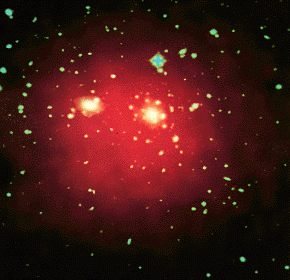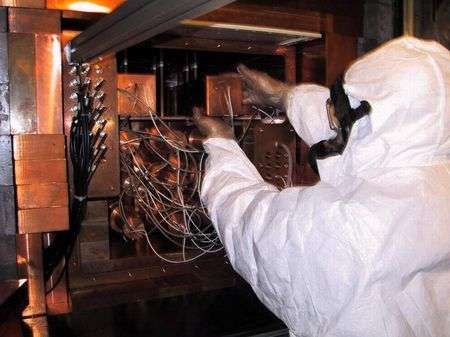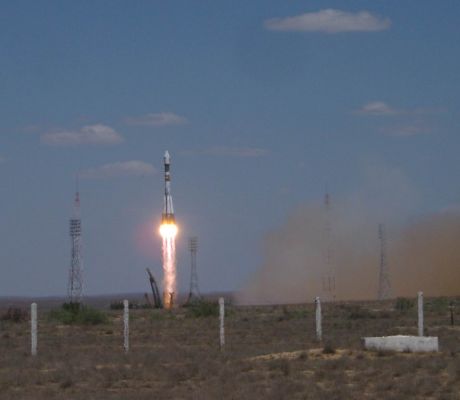Particle physicists, waiting around for new experimental results from the Large Hadron Collider, have become as fad-driven as teenaged girls. All it takes to get them going is a soupcon of a new idea, or the smallest hint of novel experimental result.

Dark matter glues galaxies together
This behavior has been on overdrive the last few months, thanks to some very weird, and maybe very exciting, observations that might finally have shed some light on the now old problem of dark matter. According to Renata Kallosh, the buzz along Stanford's corridors is that more about dark matter's secret identity may soon be revealed; so, I thought this would be a good time to look over what the fuss is about.
Dark matter has made a few appearances on this blog, but let me remind you of what the name refers to. It's a kind of matter that can't generate photons -- hence the moniker, "dark". It also happens to be, by far, the most common type of matter in the universe. We know it's there, even though we can't see it directly, because of gravity. Gravity sees everything, even dark matter, and galaxies like ours literally wouldn't hang together if they didn't have a huge amount of dark matter in them.
Because we see its tremendous effects, but don't know much else about it, dark matter is often considered to be one of the most intriguing mysteries uncovered by modern cosmological observations. One of the most irritating things about the dark stuff is that it's literally hiding under our noses. That is to say, the dark matter is whizzing around us -- and through us! -- constantly. As John Updike said in his famous poem about neutrinos which share many of dark matter's invisibility-cloak properties, "the Earth is just a silly ball / to them, through which they simply pass." Because of this, dozens of experiments around the world have been commissioned in the hope of either catching one, seeing a hint of one as it goes by, or finding traces left by them.

The DAMA Initiative
In the past year or so, and quite unexpectedly, a couple of Italian experiments on the dark matter beat started turning up some surprising clues. The first of these possible hints came from Italy's version of our simplest sort of dark matter catcher: a big vat of heavy stuff, buried deep underground, being watched by machines for hints that a dark matter particle has hit it. Italy's Gran Sasso mountain is the site for the experiment, uncreatively named DArk MAtter (or DAMA), and their claim to have seen dark matter is a controversial one.
The reason for the scientific communities skepticism is not just bias against "untrustworty" Italian experiments -- though that does unfortunately exist in some quarters. The problem with this first Italian discovery is that they see dark matter of a kind that another, competing experiment should already have seen. What's worse, the Italian experiment is widely considered to be less reliable: yet they have a discovery but the other guys don't. Since they haven't released their data for public scrutiny yet, the only resolution for this puzzle that doesn't blame too much Chianti is that the Italians use a different kind of heavy material in their detector, one that could see a very particular kind of dark matter that would be invisible to other detectors.
There were enough question marks with this experiment that it probably wouldn't have started the recent flurry of activity alone. But on the other side of the galaxy, experiments started turning up another oddity at the same time. A host of different observations of the galactic center, home of the Milky Way's boringly named black hole, Sagittarius A*, began to converge on a peculiar discovery: there are a lot fast-moving electrons and positrons -- anti-electrons -- spinning around there, far more than we ever expected to find. This was first seen indirectly, through X-rays and through other observations, which were hard to interpret.

PAMELA's launch. Will her virtue be rewarded? (Mark Pearce http://www.particle.kth.se/~pearce/)
Then the Italians turned up again, with thrilling results from their space-based electron, positron, and proton counter, called PAMELA, which should always be pronounced with one's best Italian accent. They had actually pointed their satellite at the galactic center and, lo and behold, they gathered some actual samples of these positrons. The results sent tremors throughout the physics world: where were all these extra particles coming from? The idea that dark matter was behind it all very quickly became ascendant.
Now, since dark matter is dark, but electrons aren't, it may seem confusing at first that dark matter could be the explanation for these extra electrons and anti-electrons. The only reason this was thought of is that there's not a lot else going on in the center of the galaxy: it's a boring neighborhood. But it's a neighborhood where we think there is a lot of dark matter. Therefore, if we could think of a way that dark matter could be behind it, we would not only explain the observations, but also finally figure something out about dark matter itself!
Nobel prizes were therefore at stake, which tends to make theoretical physicists very inventive. They quickly cooked up a whole host of complicated ways that the dark matter particles, all of which revolved around a central new idea: dark matter must have some chemistry. By "chemistry", I don't mean either that ephemeral feeling that we get on a good date or the bubbling beakers of popular imagination. Instead, I simply mean that dark matter could have more than one state, that instead of being a simple single particle, which is what everyone has always expected, it could be an entire complicated alternate world of interactions and events, all shielded from our view because we don't have eyes for seeing all the dark radiation and dark reactions going on. These interactions could generate all the known observed effects; some of these new models could even explain the still-unresolved mystery of Gran Sasso.
This is where things stand now. Now, skeptics abound, either bespeaking the wisdom and bitterness of fad burnout or because they didn't come up with their own model in time to claim the laurels. As they like to emphasize, the $64,000 question is whether something else could account for all this center-of-the-galaxy action. Some are coming up with yet more inventive models, like Tanmay Vaschapati, at Case Western Reserve University, who believes that the PAMELA results could be accounted for by "dark cosmic strings"--thin strings of dark matter that stretch across the universe. But the best alternate bet at present is that everything could actually come from well-known astrophysics. In particular, they point to calculations that show that pulsars -- abundant, energetic, fast-spinning, and highly magnetized neutron stars -- could in fact be the source of all the extra electrons and positrons. They could well be right. In the meantime, many people are hedging their bets, trying to locate a respectable model that they can get behind, even as they press the pulsar explanation during seminars and conferences. What the final resolution will be will be fun to watch!

http://asbojesus.wordpress.com/